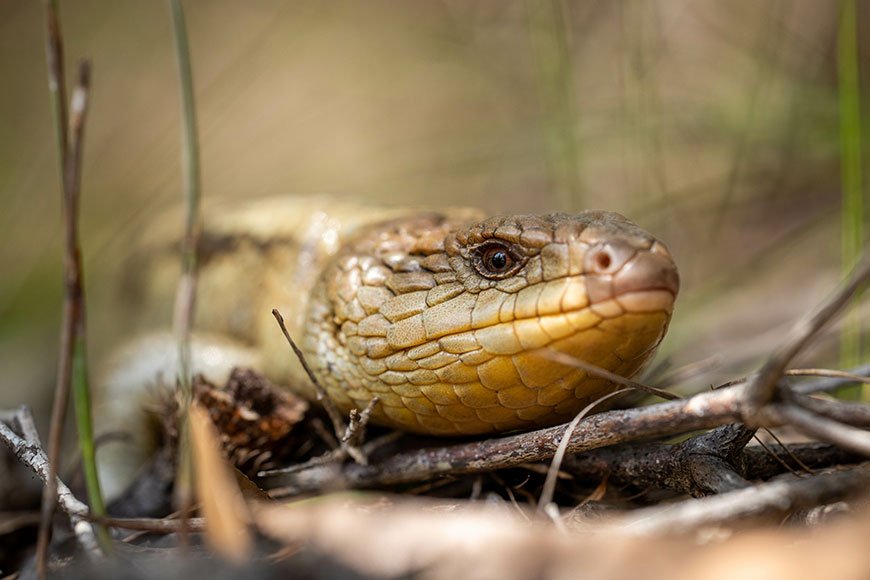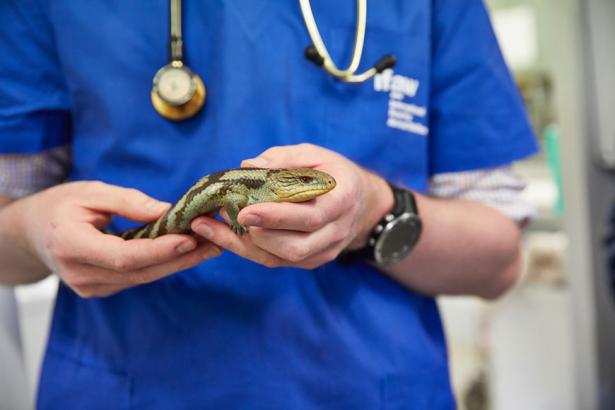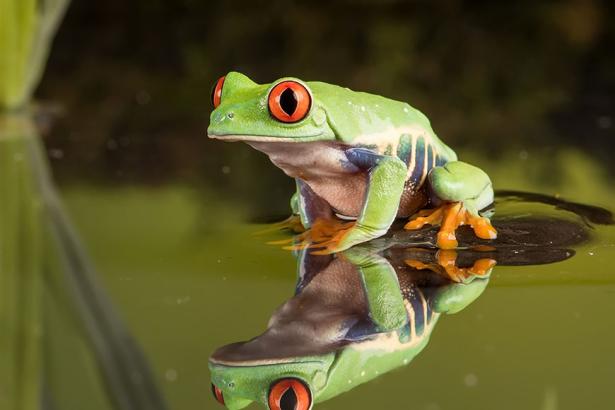The blue-tongued lizard, also known as the blue-tongued skink, is a fascinating creature that has captured the interest of herpetologists and reptile enthusiasts worldwide. This unique reptile, native to Australia, is known for its distinctive large blue tongue, which it displays as a warning to potential threats. The intensity of the colour in their tongue can vary depending on the type of predator or threat nearby. The blue tongue lizard tongue can also change shape and produce a thick mucus to help catch prey.
Native Regions of the Blue-Tongued Lizard – Australia
Whilst there are other countries (such as New Guinea and Indonesia) where you will find the blue tongued lizard, Australia has perhaps the most iconic blue-tongued skinks in the world. Many herpetologists around the globe are fascinated with these unique, docile reptiles and will even visit Australia to see them in the wild. Below we will explore the key differences in the species in their respective regions.
The Eastern Blue-Tongued Lizard
The eastern blue-tongued lizard (Tiliqua scincoides scincoides), a species of the blue-tongued skink, is native to eastern Australia as the name suggests. Found in south-eastern Australia specifically, the natural blue tongue lizard habitat varies from woodland to semi-arid deserts, showcasing their adaptability to different environments. The eastern blue tongue skink is a testament to the resilience and versatility of Australia’s unique wildlife. These skinks are the most common blue tongue lizard species and are also quite docile, making them a popular pet amongst Australians.
Habitat and Lifestyle
The eastern blue-tongued skink is a ground dweller, spending most of its day searching for food and basking in the sun. At night, they seek shelter in logs, leaf litter, or ground debris. When threatened, they puff up their bodies, stick out their long, blue tongues, and hiss – a behaviour that serves as a defence mechanism to scare off predators. Despite their seemingly intimidating display, these lizards are not venomous and pose no threat to humans – although if you harass one, you can expect a painful bite.
Diet and Predation
The eastern blue tongued lizard is an omnivorous reptile, with a diet consisting of plant matter and small animals. They have strong jaw muscles that allow them to crush big beetles and snail shells, making them beneficial in the garden as they eat snails, caterpillars, and other pests. However, they are also prey for other animals, including snakes and large predatory birds. They can also fall victim to feral dogs and cats.
The Western Blue-Tongued Lizard
The western blue tongued lizard (Tiliqua occipitalis), another species of the blue-tongued skink, is found predominantly in Western Australia. Like their counterpart the eastern blue tongue lizard, the western blue tongue skink is a testament to the adaptability of these unique reptiles, thriving in a variety of environments.
Habitat and Adaptability
The western blue-tongued skink is found in a variety of habitats, from deserts to coastal dunes. They are well-adapted to their environment, with overlapping scales that keep out dirt, sand, and debris. They shed every six weeks, reducing regular food metabolism, and are common in the pet trade.
Predation and Defense Mechanisms
Like the eastern blue tongue, the western blue tongue lizard uses its blue tongue as a defence mechanism. When threatened, they hiss loudly and flatten their bodies, making them look wider and bigger. Despite their bluff, they are non-venomous and generally docile in nature.
The Northern Blue-Tongued Lizard
The northern blue-tongue lizard (Tiliqua scincoides intermedia) or northern blue-tongue skink is the largest of all the blue-tongued lizards. They are found in Northern Australia. The northern blue tongue lizard size and distinctive colouration make them one of the most impressive reptiles on the continent. Despite their impressive size – much larger than the eastern or western blue tongue – these animals are quite relaxed, even in the wild.
Habitat and Behaviour
The northern blue-tongued skink is found in Australia’s tropical regions. They are diurnal, spending the majority of the day searching for food and basking in the sun. At night, they seek shelter in logs, leaf litter, or ground debris. The abundance of food, shelter and consistent climate would make them the envy of their eastern and western counterparts in Australia. Blue tongue lizard life may be good for this particular lizard, but the tropics come with their own set of threats like anywhere else.
Diet and Predation
Northern blue-tongued lizards are omnivores, with a diet consisting of plant matter and small animals. They have strong jaw muscles that allow them to crush big beetles and snail shells. However, they are also prey for other animals, including birds of prey and snakes, which are abundant in their region.
Southern Blue-Tongued Lizard
The southern blue-tongue lizard (Tiliqua nigrolutea), or blotched blue-tongued lizard, is found in the southern regions of Australia such as Tasmania, Victoria, South Australia and New South Wales. The blotched blue-tongued skink is a fascinating creature that calls the southern regions of Australia home. This lizard is a sight to behold with its distinct coloration and unique characteristics.
Physical Attributes and Distinguishing Marks
The blotched blue tongued lizard is a large member of the skink family, with a robust body, short limbs and is known for its unique coloration. The lowlands form of this species exhibits shades of grey or brown with paler silvery to tan coloured blotches along the back. The highlands form, on the other hand, is typically darker, often jet black, with paler cream or brightly coloured pink, salmon, or orange blotches.
Geographic Range and Habitat
This blue tongued lizard is endemic to south-eastern Australia, found in Victoria, Tasmania, South Australia, and New South Wales. It inhabits a variety of environments, including wet and dry sclerophyll forests, montane woodlands, and coastal heathlands. These lizards are ground-dwelling creatures, often found basking in the sun during the day and seeking shelter at night the same as its northern, eastern and western counterparts.
Diet and Reproduction
The southern blue-tongued lizard is an omnivore, feeding on a variety of plants and small animals. It has a particular preference for slow-moving prey like snails and beetles. Its strong jaws enable it to crush its prey with ease.
Reproduction in these lizards is an interesting process. The mating season occurs in early spring, with males aggressively competing for females. After impregnation, the embryos develop in the mother’s oviduct with the help of a well-developed placenta. The southern blue-tongued lizard is viviparous, giving birth to live young that are independent from birth.
Conservation Status and Human Interaction
Despite being a common sight in many parts of Australia, the southern blue-tongued lizard faces threats from habitat loss and predation. However, it is not currently listed as a vulnerable species. These lizards have adapted well to suburban life and are often found in backyards, where they help control pests like snails and slugs.
Blue-Tongued Lizard Facts
Blue-tongued skinks are part of the Australasian genus Tiliqua, which includes some of the largest members of the skink family. All species are viviparous, with litter sizes ranging from 1-4 in the pygmy blue-tongue and shingleback to 5-24 in the eastern and northern blue-tongues.
If you are interested in a blue tongue skink pet, we recommend you first do some research on proper reptile husbandry to decide if they are a suitable pet for you. If you would like to know how to care for a skink such as a blue tongue skink, you can read part 2 of this article here.
FAQs
There are four subspecies of the Australian blue tongue skink. The eastern blue-tongued lizard, western blue-tongued lizard, the northern blue-tongued lizard, and the southern or blotched blue-tongued lizard. All have their own distinct characteristics.
The eastern blue-tongued lizard is a species of the blue-tongued skink, native to Australia. They are found in south-eastern Australia, and their natural habitats vary from woodland to semi-arid deserts.
The western blue-tongued lizard is another species of the blue-tongued skink. They are found in Western Australia and have their own unique characteristics and habitat preferences.
In the wild, the Australian blue tongue lizard lifespan is as long as 30 years, where in captivity their life expectancy is closer to 20 years depending on their owners attention to their needs. The Australian blue tongue lizard may be known for its resilience and adaptability, but they require the correct care as a pet to live their best life.





